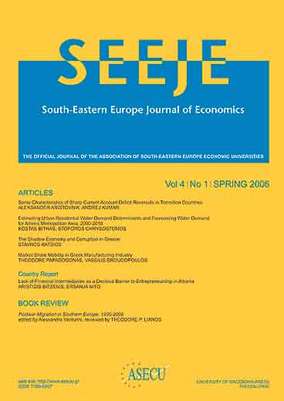Empirical test of the strong form efficiency of the Warsaw stock exchange : the analysis of WIG 20 index shares
Part of : SEEJE ; Vol.10, No.2, 2012, pages 155-172
Issue:
Pages:
155-172
Author:
Abstract:
There are three forms of information efficiency of a market that may be verified. Testing weak form efficiency provides information on reflection of the historical values of share prices. Most research on the subject proves the validity of the hypothesis that the technical analysis does not allow the achievement of abnormal rates of return. In the case of the semi-strong form the empirical research does not provide explicit answers; however, most research weighs in favour of the hypothesis of the semi-strong form of market informational efficiency. According to the hypothesis, it is impossible to achieve above-average profits in the long run, based on technical and fundamental analysis. The strong form efficiency represents another type of market informational efficiency, which is most difficult to verify, as it requires the use of non-public information. The purpose of the following article is to verify the strong form of market informational efficiency, based on the assumption that the institutions issuing recommendations have access to information inaccessible to the community of investors. The research sample consists of 3,270 recommendations produced between 1 January 2005 and 31 March 2010 by 63 financial entities with reference to companies making up the WIG 20 index. In most cases the obtained results provide evidence for the hypothesis that the strong form efficiency is characteristic of the WIG 20 index shares listed on the Warsaw Stock Exchange.
Subject (LC):
Keywords:
capital market, strong form informational efficiency, abnormal rate of return, WIG 20 index
Notes:
Περιέχει πίνακες και βιβλιογραφία, The authors extend their heartfelt gratitude to the staff of University of Warsaw (Faculty of Economic Science), especially Professor Witold Koziński and Professor Krzysztof Opolski, who have extensively supported this study. The authors are also grateful to anonymous reviewer for his constructive comments and useful suggestions., JEL Classification: C1, G1, G14, G23
References (1):
- Ambachtsheer, K., 1972, Portfolio Theory and the Security Analyst, Financial Analyst Journal, Vol.28, Issue VIAmbachtsheer, K., 1974: Profit Potential in an ‘Almost Efficient’ Market, Journal of PortfolioManagement, Vol. 28Buczek, S., 2005, Efektywność informacyjna rynków akcji. Teoria a rzeczywistość, WydawnictwoWyższej Szkoły Handlowej, WarszawaBrown, L., D., Richardson, G., D., Trzcinka, C., A., 2003, Strong-form efficiency on the TorontoStock Exchange: An examination of analyst price forecasts, EBSCO PublishingCzekaj, J., Woś, M., Żarnowski, J., 2001, Efektywność giełdowego rynku akcji w Polsce, WydawnictwoNaukowe PWN , WarszawaDimson, E., Marsh, P., 1984, An Analysis of Brokers’ and Analysts’ Unpublished Forecasts of UKStock Returns, Journal of Finance, Vol. 5Elton E., Gruber, M., 1995, Modern Portfolio Theory and Investment Analysis, John Wiley Sons,5th EditionFama, E., 1965, The Behavior of Stock-Market Prices, Journal of Business, Vol. 38, Issue 1Fama, E., 1970, Efficient Capital Markets: Review of the Theory and Empirical Work, Journal ofFinance, MayFama, E., 1998, Market Efficiency, Long-term Returns and Behavioral Finance, Journal of FinancialEconomics, AugustFitzgerald, M., 1975, A Proposed Characterization of UK Brokerage Firms and Their Effects onMarket Prices and Returns, International Capital Markets, North-HollandJaffe, J., 1974, Special Information and Insider Trading, Journal of Business, Vol. 47, Issue 3, JulyJensen, M., 1969, Risk, the Pricing of Capital Assets and the Evaluation of Investment Portfolios,Journal of Business No. 42(2)Kara, A., Denning, K., C., 1998, A model and empirical test of the strong form efficiency of UScapital markets: more evidence of insider trading profability, Applied Financial Economics,VIII, 211-220.Keown, A., J., Pinkerton, J., M., 1981, Merger Announcements and Insider Trading Activity: AnEmpirical Investigation, The Journal of Finance, Vol. 36, No. 4LeRoy, S., 1976, Efficient Capital Markets: Comment, Journal of Finance. MarchMalkiel, B., G., 2003, Błądząc po Wall Steet. Dlaczego nie można wygrać z rynkiem, Wig-Press,Warszawa.Malkiel, B., G., 1992, Efficient Market Hypothesis in: New Palgrave Dictionary of Money andFinance, Macmillan, London.Morse, D., 1998, Asymmetrical Information in Securities Markets and Trading Volume, Journal ofFinancial and Quantitative Analysis.Penman, S., H., 1982, Insider Trading and the Dissemination of Firms’ Forecast Information, Journalof Business, Vol. 55, No. 4.Przekota, G., Szczepaska-Przekota, A., 2008, Analiza empiryczna efektywności polskiego rynkuakcji, Ośrodek Analiz Statystycznych 2008.Szyszka, A., 2003, Efektywność giełdy papierów wartościowych na tle rynków dojrzałych,Wydawnictwo Akademii Ekonomicznej w Poznaniu.Ślepaczuk, R., 2006, Anomalie rynku kapitałowego w świetle hipotezy efektywności rynku, e-FinanseNo. I.Ziarko-Siwek, U., 2005, Efektywność informacyjna rynku finansowego w Polsce, CeDeWu, Warszawa.




